| Make: Analog Synthesizers |
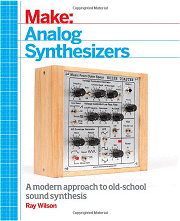
|
|
Ray Wilson wrote the seminal guide to analog synth DIY and it’s still available! The book covers tools, equipment, synthesis basics, hot tips and companion content for the Noise Toaster project!
|
|
BUY NOW!
|
| My Electronic Compositions |

|

|
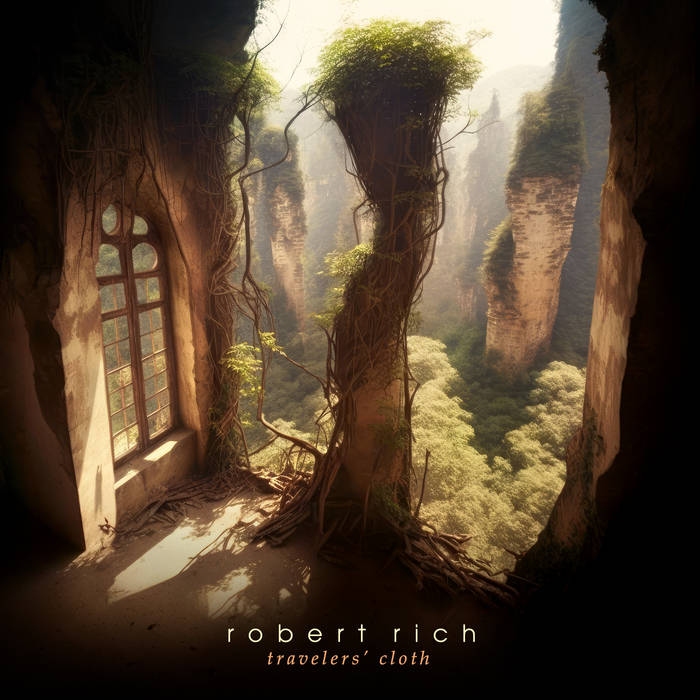
|

|
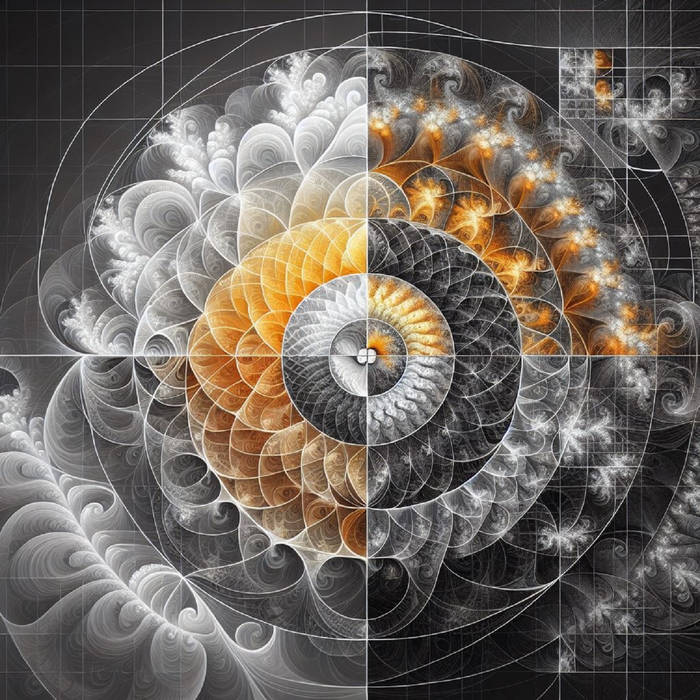
|
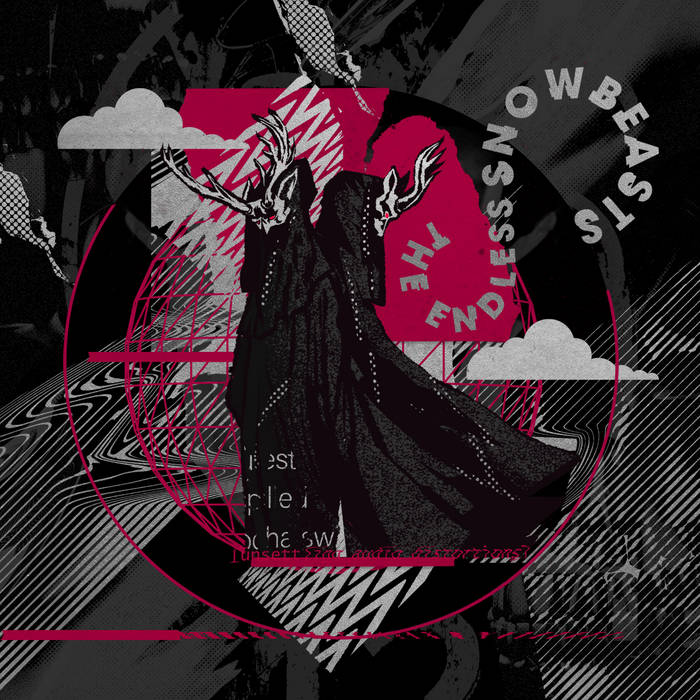
|
|
When the last component is soldered and the last bug is found and fixed, it's time to realize the
purpose of all your hard work and actually produce "electronic sound" with your gear. I'm not going
to call it "music" because music is a very subjective term. Birds chirping might be music to someone.
A jet going over in the distance might evoke a feeling for someone else. These are some of
my "sounds". Some atonal, some musical others more environmental in nature. If you click an image
you can download individual tracks for 99¢. Great for yoga and meditation. Namaste.
|
| Quad Timbre Bank |
|


|
|
We're always looking for ways to make things sound new and different.
If you're looking for more timbre take a look at the
MFOS Quad Timbre Bank
|
| Alien Screamer |
|
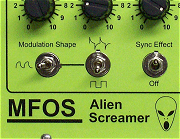
|
|
The MFOS Alien Screamer
is a simple 9V powered noise box that will keep you and anyone in earshot
entertained for days. This project is along the lines of the WSG in complexity and capability.
|
| MFOS VC Echo Module |
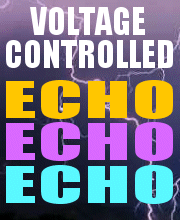
|
|
The new MFOS Voltage Controlled Echo Module is here!
Learn to use the PT2399 Echo Processor Chip, one of the coolest chips going.
|
| Selecting CMOS |

|
|
When MFOS projects call for CMOS ICs Always buy the
buffered type (CD4013BCN for example). The "B" in the part
number stands for buffered output. When
you see a plain number like CD4013, CD4081, CD4042
and/or other CMOS chips listed in a project part list always
buy "B" type chips for example: CD4013BCN, CD4081BCN, CD4042BCN, etc.
Remember to observe static precautions when handling any CMOS chip.
Good building!
|
| Synth Interfacing |
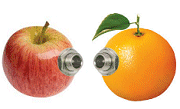
|
|
Learn how to safely connect your MFOS gear to your
synth without letting the magic smoke out of either
one. Go...
|
| BIPOLAR CAPS |
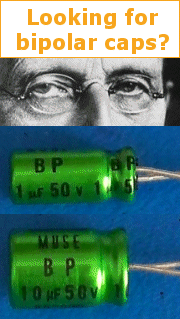
|
|
Bipolar 10uF 50V (5 Pack)
Bipolar 1uF 50V (5 Pack)
|
| Mini Mixer & 1W Amp |
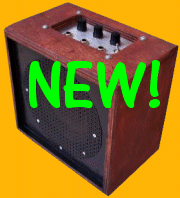
|
|
This 9V battery powered 3 input mixer and 1W amplifier will let you take your battery
powered noise boxes anywhere you want without worrying about whether you'll have power
or not. Whether you're going camping, mountain climbing, or on a Peruvian meditation retreat
now you can hear your battery powered synth wherever you are. Just remember to bring along a
few 9V batteries.
|
| Pocket Protectors Back! |
|
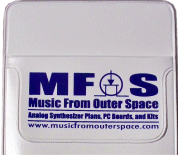
|
|
All scientists, physicists and engineers know that after the degree
from a prestegious university a pocket protector is standard equipment.
Be ready to record your next idea by having a - protected - pocket full of
pens and pencils.
|
| Pay with PayPal |
|
MFOS recommends PayPal for all your
synth-diy purchases. It's secure and
sign-up is free.
How to purchase from MFOS...
|

|
| Ray's Op-Amp Webcast |
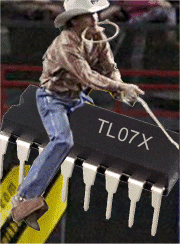
|
|
Thanks to everyone that attended the TL07X op amp webcast.
Maker Media was kind enough to provide me with an MP4 of the webcast which
I have posted on YouTube. You can also download the presentation PDF below.
|
|
| Poster Campaign |

|
|
If your school or university has a place where they allow you
to put commercial posters I would appreciate it if you printed
this one out and hung it up. MFOS' mission is to bring synth diy to
the masses. Thanks!
Get the MFOS poster (pdf)
|
| MFOS Oct-Attenuator |
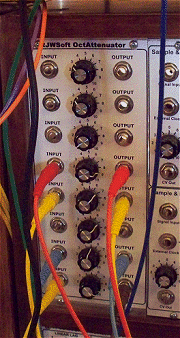
|
|
Build an Oct-Attenuator for your MFOS modular.
This module adds 8 generic attenuators
to your modular for adjusting voltage outputs
and modulation levels. A super simple project.
|
| Oldish MFOS T-Shirts! |
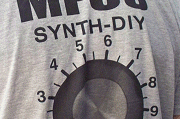
|
|
These
oldish MFOS t-shirts
are really comfortable. Our logo on a sports gray GILDAN Softstyle 90% cotton and 10% polyester t-shirt.
Let the world know you're a synth-diy jedi master.
|
| MFOS Wave Freaker |
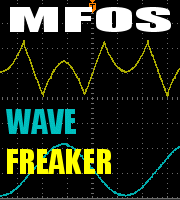
|
|
The MFOS Wave Freaker
is making itself at home in a wide variety of commercial and diy synths.
Sounds from subtle to "IN YO FACE" phat. Thanks to all of the customers that
are helping to make this module a success.
|
| Brackets Anyone? |
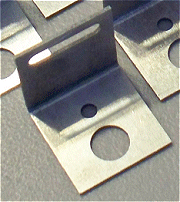
|
|
These
universal brackets are very useful when mounting
a PC board to your front panel.
|
| MFOS IN THE CLASSROOM |
|
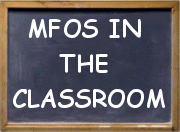
|
|
There are several articles and applications on the MFOS site
useful to electronics educators. Here is a list of links.
Virtual Op-Amp Lab
Reading Resistors
Capacitors
Resistors in Parallel
Analog Synthesizers 101
Electronic Components
|
| Virtual Op Amp Lab |
|
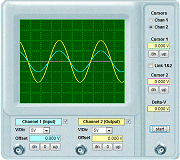
|
|
I made this tool to help me when I need the results of an op amp setup quickly.
You may find it useful. It is idealized and simple but gives a decent approximation.
Check it out!
|
| Sawtooth to Triangle |
|

|
|
Convert your Sound Lab (Mini-Synth, Mark II, and ULTIMATE) synthesizer
ramp or sawtooth waves to triangle waves. Great way to prepare ramp or
sawtooth waves to use the Wave Freaker.
Check it out!
|
| Bend Your WSG |

|
|
Some simple mods for the WSG that will keep you making weird sounds into the next century.
|
|
|
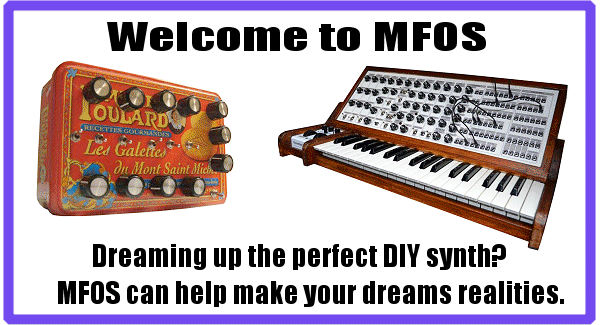
|
If you're into electronics, can solder and trouble-shoot and you love analog synthesizers we
have tons of cool projects for you. Spend some time browsing and you'll find lots of inspiration.
Our mission is to help people realize their analog synthesizer dreams by providing: complete
schematics, assembly drawings, professionally manufactured PC boards, cool face plates and kits
as well as hard to find electronic components. Learn more - check out these links:
Getting the Most Out of the MFOS Website...
From Getting Started To Your Very Own Analog Modular...
Introduction to Analog Synthesizers...
Anyone can start learning about electronics...
Books About Electronics and Analog Synthesizers...

|
| Build the Sound Lab Mini-Synth Mark II Analog Synthesizer |
|

|
The Sound Lab Mark II
will surprise you with its array of sound shaping modules. Check out the
sound samples below which were made with the Sound Lab Mark II.
SONAR X1's effects used for reverb, never for pitch correction. The VCOs and VCF in the Mark II
track very well after thorough calibration. Check out these YouTubes!
MFOS Stocks the harder to find components for this project
which you can order at the time you order your PC board and
professionally machined front panel.
 |
Check out music by musician Quincas Moreira from Mexico City.
These amazing songs were done entirely using his hand-made
Sound Lab Mark II. Very cool & creative works of art.
ElectroCumbia
Woody Groove
|
For these samples I used SONAR Producer Edition for recording, mix down, and addition of reverb.
All sounds are directly from the Sound Lab Mark II driven via a MIDI to CV convertor or MFOS Single Buss Keyboard Controller (the last was recorded real time).
 | Prelude and Fugue in C No. 2 - J.S. Bach |
 | Three Part Invention in C No. 1 - J.S. Bach |
 | Sound Lab Mark II Symphony - RJW |
 | Song tail w/the SLMS Mark II - RJW |
|
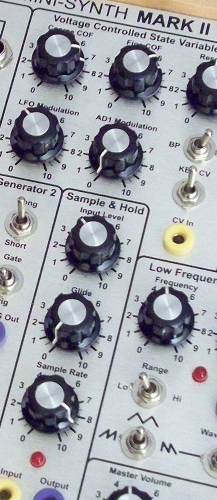
|

|
Laurentide SynthWorks Sound Lab Mark II YouTube
Laurentide SynthWorks published an excellent example of what can be done
with the Sound Lab Mark II. It explores a lot of the Mark II's sound nuances.
In a blind test it would be interesting to learn which analog synth people thought
they were listening too if they didn't know this was an MFOS Sound Lab Mark II.
Effects are added but the synth comes through loud and clear.
Thank you Laurentide SynthWorks.
|
|
| Sound Lab Mark II 17 x 7 Inch Panels Are Here |

|
|
The Sound Lab Mark II Faceplates are ready for prime time. These plates work well
with BUD Box AC-423 as a ready made case. They are .09" thick which is nice and sturdy
even at 17 inches wide. These are perfect for building your next rack mount
Sound Lab Mark II analog synthesizer.
Check it out...
|
| NOISE TOASTER |
|
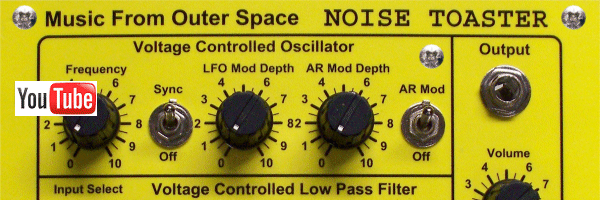
|
|
The MFOS NOISE TOASTER
is way more fun than you thought was possible with a 9V battery!
It's an awesome little 9V powered noise box that's like carrying around a miniature synth.
This project is a bit more complex than the WSG but has far more sound shaping and producing capability.
This is going to be one of your favorite portable toys (amp and speaker built in). PCBs and PLATEs IN STOCK!
|
| The Venerable Yet Flexible Synth-DIY Experimenter PCB |
|
Synth-DIY Experimenter PCB
This project helps creative electronics hobbyists
who have successfully completed the WSG learn more
about synth-diy. You make "patches" with the Sound
Effects project by patching the various "modules"
together, and adjusting knobs and switches.
CLICK HERE TO GO TO THE PROJECT!
Multi-track demonstration of sounds you can expect (reverb has been added during mixdown):
 | SDIY Experimenter Board Opus 1 - RJW |
A *.sfz compatible soft-synth and samples of sounds made with the MFOS Synth-DIY Experimenter PCB
were used to create this cool multi-track version of Tchaikovsky's "Dance of the Sugarplum Fairy".
 | Dance of the Sugarplum Fairy - Tchaikovsky |
|
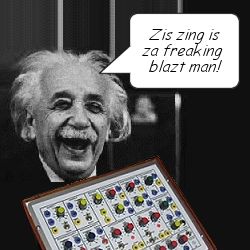 |
|
The Synth-DIY Experimenter PCB contains some of the first synth circuits I started experimenting with
when I first got into synth-diy.
You don't have to build all of the modules. You can just build what you want to make a specific sound.
You want wind... just build the White Noise Generator and one VCF.
You want better wind build the White Noise Generator both VCFs and the output mixer.
How about birds or bell sounds... just build the Sound Effect Oscillators an AR Envelope
Generator and an LFO. You can go as far as you like with this project.
This project will NOT result in a 1V/octave Moog like instrument but it will provide you with a lot of sound making fun.
In any case it will be a fun learning experience and the finished project will keep you and anyone else within earshot very entertained.
|
| The Sound Lab ULTIMATE. Our most advanced synthesizer project. |

|
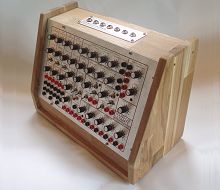
|
|
The Sound Lab ULTIMATE packs: Three Musically Accurate VCOs, a White Noise Generator, an Active Mixer, a Voltage Controlled LP Filter,
a Voltage Controlled Amplifier, an Attack Release Envelope Generator, two Low Frequency Oscillators,
a Repeat Gate Generator, Sample & Hold, Attenuator Bank and Patch Panel into one totally cool synth-DIY project.
The following songs played by my amazing daughter Arielle Wilson on the ULTIMATE.
|
|
 | Original Star Trek Theme |
 | Star Trek Next Generation Theme |
|
|
|
|
bchris1776's Sound Lab ULTIMATE/EXPANDER YouTube
bchris1776 published an excellent example of what can be done
with the Sound Lab ULTIMATE and EXPANDER. Just a totally cool sound
exploration. Effects are added but the synth comes through loud and clear.
A driving sequence is accompanied by Pink Floyd sounding runs. A totally cool watch.
Thank you bchris1776.
|

|
|
| MFOS Delayed Modulation Module |

|
|
The MFOS delayed modulation module includes an Attack Release envelope generator, Low Frequency Oscillator with
square and sine waveforms, and a Voltage Controlled Amplifier. These separate elements are connected in the
classic delayed modulation patch such that the LFO is fed to the input of the VCA and the AR generator is connected
to the VCA's control input. When you apply a gate to the circuit the AR generator is gated on and the VCA responds to the applied envelope and
the LFO comes through the VCA. You use the output of the module to modulate other voltage controlled modules. Since
there is a complete AR generator built into the module you have some really excellent flexibility.
Check out the Delayed Modulation Module project
|

|
| The venerable Sound Lab Mini-Synth. Old school analog and still going strong. |

|
|
The Sound Lab Mini-Synth is a great project. It is a complete mini analog synth on
one PC board. It has two VCOs, one LFO, one Mixer, one State Variable Low-Pass/Band-Pass
Filter, one AR Envelope Generator with repeat, and one VCA. It runs off of two nine volt batteries for a long time
due to its low current design.
Check out the MINI-SYNTH!
|
|
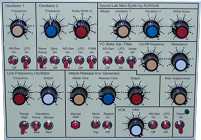
|
 |
COOL PROJECTS for your Mini-Synth
Sound Lab Mini-Synth Sample & Hold!
Sound Lab Mini-Synth Drum Trigger!
Sound Lab Mini-Synth Guitar Trigger!
Sound Lab Mini-Synth Parts Kits!
SLMS Windows WAVs!
 | Listen to a multi-track Sound Lab demo! |
|
|
| Contribute a Composition to the Art of Electronic Sound Project |
 |
You've put blood, sweat and tears into building your very own analog synthesizer. Show the world what it can do.
Contribute a composition to
"The Art of Electronic Sound"
project so other creative synth-diyers can be inspired.
Whether you create: traditional, twelve tone, noise, soundscapes, dreamscapes, space music or something further out,
as long as it's electronic and you built some of the gear, we want to hear it. The duration of your piece can be
short or long and the content simple or incredibly textured. Whether you're a newbie or someone who's been building
for years submit a composition. Your composition might be the one heard by a famous filmmaker looking for an obscure electronic sound track.
|
| 16 Step Sequencer Quantized Vari-Clock Module |
|
Quantized duration adjustment literally adds a new dimension to your MFOS 16 Step Sequencer.
Check out our new project. It gives the MFOS 16 Step Sequencer the ability to
have settable duration per step in 16 quantized increments as well as multiple gate modes. It is definitely
an advanced and challenging project but I tried to document it thoroughly.
Thank you for your thoughtful comments on this project.
I think you'll really like the functionality provided by this circuit.
Click here to go to the project.
Check out the YouTube...
|
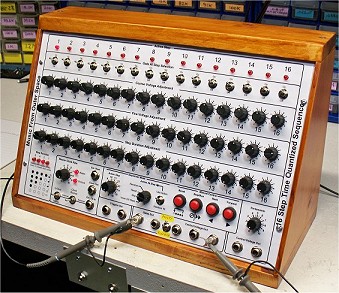 |
| The MFOS Mini-Controller. This is too cool not to have so what are you waiting for? |
|
The MFOS Mini-Controller
The MFOS Mini-Controller has a twenty nine note stylus keyboard (C - C - C to E) built right into the PCB.
It can be used to play your Sound Lab Mini-Synth or 1V/Oct modular.
The PCB supports four CV outputs (2 with portamento 2 without portamento).
There is one trigger output and one gate output.
This and a Sound Lab Mini-Synth would make a great combination for your first forray into synth-diy.
|
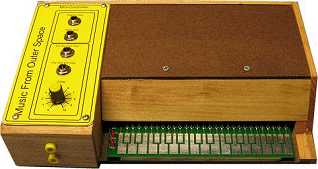
|
| Some Component Clarification |
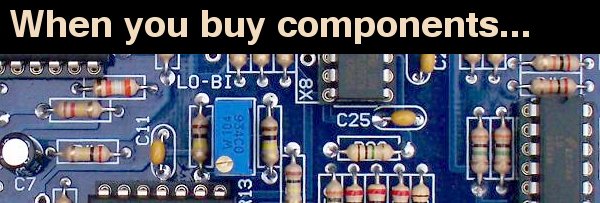
|
|
Every MFOS project has a parts list (also called a BOM) that lists all of the components needed for the
project. Experienced project builders know what types of components to buy when it comes to
working voltage, power rating, lead spacing, etc. For those newer to synth-diy, here are some
clarifications and pointers.
Resistors
I recommend 1/4W 5% carbon resistors for general project use. You can always substitute a resistor with tighter
tolerance for one with less precision. For example: 0.1% or 1.0% metal film resistors can be used anywhere a 5%
carbon film resistor can be used.
Projects will call out when more precision is required specifying 1/4W 1% metal film resistors.
Occasionally a project will recommend sorting 1/4W 1% metal film resistors to obtain greater accuracy.
MFOS also sells 1/4W 0.1% tolerance 100K and 200K metal film resistors for use in MFOS circuits that use
A/D and D/A convertors (see the catalog under Electronic Components).
If a resistor in a circuit is high in value you can get away with using 1/8W instead of 1/4W but you must
determine the current through the resistor and voltage across it in-circuit to ensure the 1/8W will be
appropriate. The boards are laid out for 1/4W resistor packages so 1/8 watt resistors will look a little
odd but they'll work fine.
Capacitors
I call out ceramic caps (for non-electrolytic ones) most often in projects but you can substitute
film caps for any of them. Buy capacitors rated for 35V or greater for any and all MFOS projects.
When I call out polystyrene caps it is because the circuit requires the lowest leakage cap available.
If you substitute other types the circuit performance directly related to the cap will suffer. Sample and
Hold circuits will leak faster without polystyrene caps. Often the boards are laid out for 0.2" (5mm) lead
spacing caps. Components with wider or narrower lead spacing will work but you will need to do some lead
forming using tweezers or needle nose pliers.
For electrolytic caps be sure and buy ones with a voltage rating that is higher
than any voltage that will seen while in-circuit. This will generally be the power supply voltage. For projects
powered with +/-9 to +/-15V I would recommend capacitors rated for 35V. Buying 35V caps provides a bit of safety
margin and they're very obtainable from suppliers. Higher working voltage caps will work fine but not
lower working voltage. As a matter of fact, caps rated for 35V will work fine for all capacitors in all MFOS
projects.
Non-polarized caps (also called bipolar) provide a large capacitance but are non-polarized. They look very much like
electrolytic caps except that instead of having a positive side and a negative side the two sides are interchangeable,
the cap is not polarized. Many suppliers have these. Search for bipolar capacitor. MFOS sells 5-Packs of
1uF and 10uF bipolar capacitors (see the catalog under Electronic Components).
Potentiometers
Potentiometers in all MFOS circuits can be linear if you can't find audio taper. You can go the other way
but you will probably see some unexpected behavior. Potentiometers in all MFOS circuits can be rated for 1/8W
and up (1/4W, 1/2W, etc). You can use the large potentiometers or the smaller sized ones, it makes
no difference. Just be sure the pots you buy will fit into your panel.
Trimmer potentiometers should be the multi-turn square Bourns top adjust style (3296W). They don't have to
be actual "Bourns" brand trim pots, they just need to be the same style. Tayda sells nice ones at reasonable
prices.
Integrated Circuits
Be sure and buy DIP style ICs. The small format ICs have become ubiquitous so double check what you order
or you'll get a bunch of teeny tiny ICs. In part lists I only give the main IC number (example TL074 or TL071)
but there will always be a suffix that indicates the package type and the expected
temperature range when you go to buy the ICs (examples TL074CN and TL071CP).
Buy the least expensive version of the IC in DIP format. Plastic or ceramic package material makes
no difference to the circuit's performance. Consumer Electronics temperature range (the most restricted)
is fine.
I call out the LF444CN for projects that require an op amp with the lowest input current and
corresponding highest input impedance. Sample and hold circuits benefit from the LF444CN.
When MFOS projects call for CMOS ICs Always buy the buffered type (CD4013BCN for example). The "B" in the part
number stands for buffered output. When you see a plain number like CD4013, CD4081, CD4042 and/or other CMOS
chips listed in a project part list always buy "B" type chips for example: CD4013BCN, CD4081BCN,
CD4042BCN, etc. Remember to observe static precautions when handling any CMOS chip.
Switches
I recommend mini-toggle switches but you can use any type of switch that serves the function
called out in the schematic. Some folks might like really large switches for an art installation and
other people might want to go with submini-toggle for really tiny or really crowded face-plates.
When buying switches be sure and buy the correct type. When center-off switches are specified be
sure and look for ON-OFF-ON in the specification. The OFF in the middle of the two ONs means center-off.
The type that are not center-off use either ON-ON or ON-NONE-ON to indicate the fact that there is no
center position.
In a battery powered unit all of the switches can be low power (500mA to 1A).
However for a mains powered unit I recommend that the power switch used handle
at least 5A. All other switches can be rated for 500mW and up. The synth
module switches never carry a significant current load.
Wire
I recommend 22 to 24 AWG stranded hook-up wire for wiring panels to PC boards.
All Electronics sells 25' and 100' rolls of nice quality stranded hookup wire.
For COAX you need a supple thin wire with braided shield and stranded center conductor.
Something similar to RG174/U w/braided shield and stranded center conductor 2.5mm outer diameter.
You'll have to search around on this one but I found it on this site: http://www.pasternack.com.
If I get more inquiries I'll answer them here. Cheers.
|
| Will MFOS circuits work with a +/-15V power supply? |
|
All MFOS circuits will work with +/- 15 volts with from none to
minor value changes. All of the chips I recommend are rated for the higher
voltages so you should be good to go. One small consequence
is that the peak voltage of things will be a bit higher. Oscillator P-to-P
outputs will be higher at higher supply voltages and AR or ADSR voltage peaks
will be higher also. Filters and amplifiers will have more
headroom and may need a bit of re-biasing if you find that the output is not
sitting at ground when the input is at ground.
For any circuit to which you want to apply higher supply voltage
examine the schematic and you'll find its not difficult to reduce the
output voltage to what you want. Where bias levels are set with resistor
dividers you may need to tweak values.
If it absolutely, positively has to be there with
a different supply voltage; breadboard it, apply the voltage you want, and tweak as necessary.
|
| Open Source Philosophy |
|
Everything on Music From Outer Space is free for non-commercial use.
Please feel free to use the information presented on the MFOS website to the fullest extent for non-commercial uses.
You can make your own PCBs from the layouts and drawings we provide or design your own if you prefer.
We appreciate a link to us if you blog or YouTube your work.
MFOS sells professionally made glass epoxy, double sided, plated through PC boards, electronic parts, parts kits and faceplates for many of the projects found here.
Please keep in mind that although I use these circuits in my synth I recommend that you review them thoroughly and/or breadboard
them before relying on them to make sure they'll meet your expectations.
If you find errors or omissions in the project documentation please email the details to
the email address at the bottom of the page so we can correct them and continue to improve
the site. Thanks.
Commercial Use
Doing business with MFOS couldn't be easier...
|
|
| EXPRESS ROUTE TO WSG |

|
| MFOS Echo Rockit |

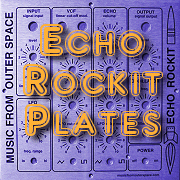
|
|
The 9V battery powered Echo Rockit makes some of the most unusual sounds I've heard. Any seasoned electronics diyer could build one.
Hey what was that... a modular or... an
Echo Rockit?
|
| MFOS Mobile Site |
 |
|
We are now mobilized as much as practical.
You can search, listen to Sound Art and order
MFOS products from your mobile now. There is
still large format content that is best viewed
using a larger viewer but getting around with
a phone should be much easier.
|
|
| Ordering Information |
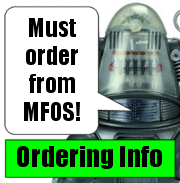
|
| Wave Former |
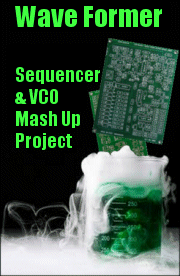
|
|
The MFOS Wave Former mash-up project
puts the MFOS VCO and the MFOS 10 Step Sequencer
together to create a simple arbitrary waveform generator.
Add some new timbre to your set up.
Go check out the project...
|
| Cool Function Generator |
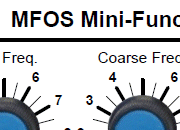
|
|
Build this cool little battery powered function generator.
Low current design will keep this thing going for a long time.
Keep one in your toolbox.
Go check out the project...
|
| MFOS Vocoder |
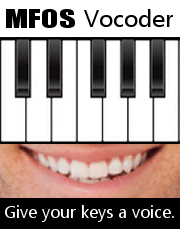
|
| Trouble Shooting Tips |

|
|
When everything doesn't go just right with your project
you may need to consider some of these trouble shooting tips.
Chin up, don't panic, you'll get... whatever it is... working!
|
|
| Substitute Op-Amps |
|
In the table that follows I show op amps that can
be used to sub others shown in some older schematics.
Note however that the LF44XCN can be replaced only
when not used in sample and hold applications.
All op amps must be in DIP format.
|
| Op-Amp | Sub. | Pkg. |
|---|
| LF444 | TL074 | 14P-DIP |
| LF442 | TL072 | 8P-DIP |
| LF441 | TL071 | 8P-DIP |
| TL084 | TL074 | 14P-DIP |
| TL082 | TL072 | 8P-DIP |
| TL081 | TL071 | 8P-DIP |
|
| More DIY Sites |

|
|
Visit
other DIY sites
that share cool information.
|
|
| synthCube Newsletter Sign-up! |
|
|
| NEW! V/Oct Calibrator |
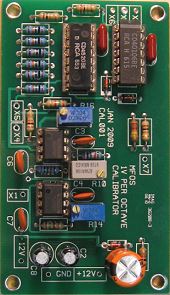
|
|
This circuit makes calibration of your volt per octave equipment way easier.
Build one today and get in tune.
Read more...
|
| ULTIMATE EXPANDER |
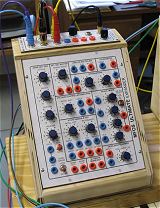
|
|
Designed as a companion for the Sound Lab ULTIMATE
the EXPANDER has become the favorite "Swiss Army Knife"
module of many advanced synth builders.
Read More...
|
| Share MFOS on Facebook |
|
We really appreciate FB shares. Help more people discover Synth-DIY. Thanks!

|
| Matched 2N3904s & Tempco |
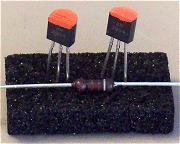
|
|
Hand matched pair of 2N3904 transistors (Vbe of pair within 2mV)
and a 2K 1/4 watt 2% +3300 ppm metal film tempco.
Great for VCO or VCF expo convertors like those in the:
- Sound Lab Mini-Synth...
- Sound Lab ULTIMATE...
- ULTIMATE EXPANDER...
Great deal at a great price!
|
| Swiss OpAmp Knife |
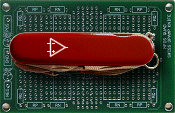
|
|
Three (3) pack of great quad op amp kludge boards for when you
need some extra op amp related circuitry and you want a quality
pc board to put it on. Glass epoxy, plated through holes, solder
masked it's the creme de la creme of op amp kludge boards.
|
| MFOS uses DIP |
|
Always order DIP package chips for MFOS boards.
No offense SOP packages but gentlemen prefer chips with longer legs.
You can also buy type adapters.
DIP Spec. vs.
SOP Spec.
|
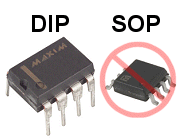
|
| The Fine Print... |
|
This website assumes a basic level of
electronics proficiency and knowledge. To build the projects found here you must be able
to understand schematics, be familiar with electronic components, solder, do
panel wiring, case building, and troubleshoot. MFOS projects do not have step by step
instructions. There are; schematics, circuit descriptions, pc board layouts,
suggested panel layouts, and suggested modifications. Please read any project's information
in its entirety before buying products. Just getting started? Read this:
Getting Started...
All information presented on the Music From Outer Space website is provided "as is" without
warranty of any kind. MFOS product prices are subject to change without notice.
The information provided by this website is only intended to be general
summary information to the public. Please study carefully or breadboard
circuits to be sure you will be happy with the results before you purchase MFOS
project PC boards, Parts or Kits. Thank you - have fun.
|
|